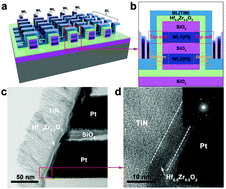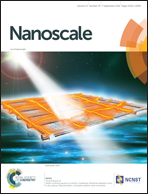Ultra-low power Hf0.5Zr0.5O2 based ferroelectric tunnel junction synapses for hardware neural network applications†
Abstract
Brain-inspired neuromorphic computing has shown great promise beyond the conventional Boolean logic. Nanoscale electronic synapses, which have stringent demands for integration density, dynamic range, energy consumption, etc., are key computational elements of the brain-inspired neuromorphic system. Ferroelectric tunneling junctions have been shown to be ideal candidates to realize the functions of electronic synapses due to their ultra-low energy consumption and the nature of ferroelectric tunneling. Here, we report a new electronic synapse based on a three-dimensional vertical Hf0.5Zr0.5O2-based ferroelectric tunneling junction that meets the full functions of biological synapses. The fabricated three-dimensional vertical ferroelectric tunneling junction synapse (FTJS) exhibits high integration density and excellent performances, such as analog-like conductance transition under a training scheme, low energy consumption of synaptic weight update (1.8 pJ per spike) and good repeatability (>103 cycles). In addition, the implementation of pattern training in hardware with strong tolerance to input faults and variations is also illustrated in the 3D vertical FTJS array. Furthermore, pattern classification and recognition are achieved, and these results demonstrate that the Hf0.5Zr0.5O2-based FTJS has high potential to be an ideal electronic component for neuromorphic system applications.



 Please wait while we load your content...
Please wait while we load your content...